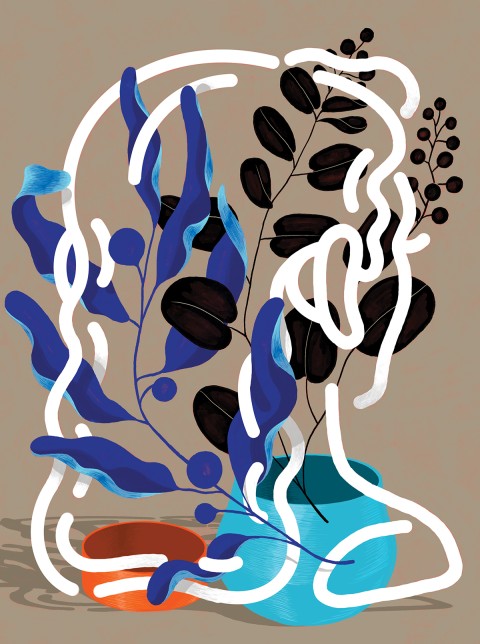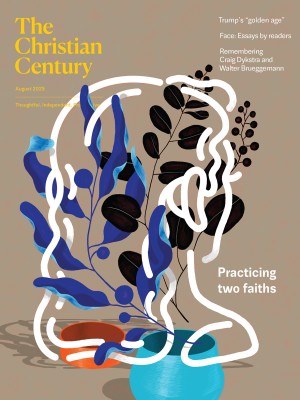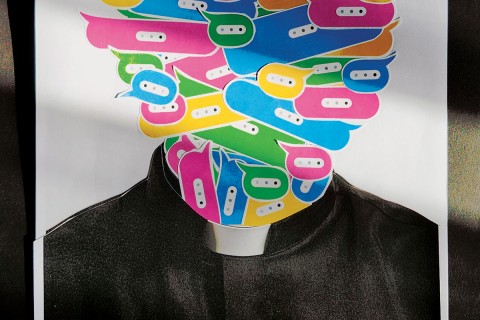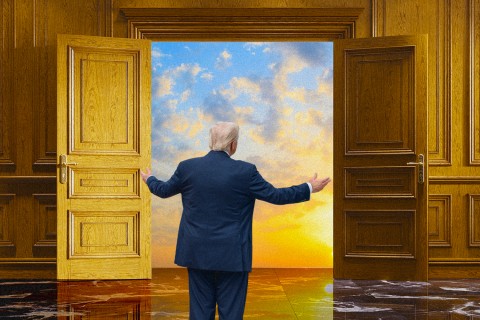How I became religiously multiple
I’m on a personal journey into Buddhist–Christian belonging.

Illustration by Bryce Wymer
At the ceremony, I was given the name Dvesatya (pronounced Dvay-SUHT-yuh). My teacher, Shinkyu Brian Coté, explained: “In Sanskrit, dve is ‘two.’ Satya is ‘truth, reality, things as they are.’ Together, Dvesatya is ‘Two-Truth.’ . . . Your name speaks to both the duality (dve) and the non-duality (satya) of the two great religious traditions that are alive in your practice, Buddhism and Christianity. May they continue to work together as one through you.”
This was an important milestone on a journey I couldn’t have foreseen even a year or two earlier, a journey into multiple religious participation.
I converted to Christianity as a teenager, after getting to know some Christians who genuinely tried to put Jesus’ teaching to love your neighbor as yourself into practice. Then I studied Bible and philosophy in college and became enthralled with theology, pursuing my curiosities into seminary and beyond. Christian theology has always fascinated and inspired me—and frustrated and confounded me. Speaking of the latter, I’ve wrestled again and again—in one form, then another—with Christianity’s tendency to exclude other people, perspectives, and paths.
Read our latest issue or browse back issues.
When I was in college, I struggled with the mainstream Christian teaching that some, and likely most, will ultimately be excluded from eternal salvation. I had always had non-Christian friends and family. For me, the so-called lost were people I knew well, people I loved and admired. It didn’t make sense to me that the same God who wanted me to love my neighbor as myself would eternally exclude even one of those whom God so lovingly created in God’s own image. And when I dutifully explained to my non-Christian neighbors that, for their own eternal well-being, they needed to give up whatever non-Christian religious beliefs and traditions they might have and convert to Christianity, that didn’t feel like love. Thankfully, I eventually discovered a solution to the conundrum: the ancient Christian teaching of universal salvation. But this was only a partial solution.
In seminary, I started to think of salvation a bit differently: as Jesus giving us a new way of being by transforming us into his image in this life. Perhaps, I thought, there might also be an afterlife component to salvation, but salvation at least begins here. And this raised an important question: Even if everyone is saved in the hereafter, are non-Christians excluded from the transformation—the salvation—that Jesus brings in this life? If God is love, and God is everywhere and everywhen, how could God be okay with that? Thankfully, I then discovered the kind of inclusive theology that sees Christ at work everywhere, including in other religious traditions. I came to think that, in one way or another, everyone encounters Christ and is transformed into his image—that everyone experiences salvation in this life, in some sense and to some degree, even if they don’t have the words for it. In this inclusive theology, I had found yet another solution for Christianity’s tendency to exclude. But this too was only a partial solution.
Something about the picture still bothered me, and I struggled to put my finger on it in my post-seminary years. Then one summer day in 2020, as my friend Adam and I were on our way to play tennis, he said to me, “My biggest problem with Christianity is how exclusive it is.” I remember wanting to protest, “Well, the Christianity that I practice, that I ascribe to, isn’t exclusive!” But then—setting aside for the moment the sense of superiority and wounded pride evident in my internal monologue—I realized I couldn’t quite claim that. There was, in fact, an important way in which my understanding of the faith was still quite exclusive: it excluded the possibility that the access to truth enjoyed by non-Christian traditions might be every bit as good as the access to truth enjoyed by Christian traditions.
Sure, I could say all kinds of broad-sounding things: everyone experiences salvation; no one is left out; God encounters people and transforms them not only through all kinds of religious traditions but also through philosophy, art, social movements, family, friends, nature, and so on. And yet, according to my view, it was Christians who had the inside scoop on what was really going on in each and every one of these transformative experiences.
I could say to Adam, “In my view, everyone is included, even if they don’t have the words for it.” But I believed that Christians did have the words for it. To clarify: I didn’t believe that Christians had all their ducks in a row, that any Christian theologian had—or even could—come to an exactly right account of who God is, what God is up to, and what it all means for us practically. But because of how I understood Jesus and the church’s connection to Jesus, I was committed to the conclusion that the most adequate account of God and what God is up to in the world would inevitably be a Christian account. In terms of access to truth, it seemed that Christianity must be in a league of its own. Consequently, I held that the Christian faith would do a better job of connecting people with God, truly and savingly, than any other religious tradition. In my view, Christianity was superior.
But by that time, the idea that we Christians are the recipients of an unparalleled revelation that affords us superior insight into saving truth—a depth of insight from which our non-Christian neighbors are excluded—had simply failed the test of experience for me. I could no longer believe it. I had learned too much about the messy historical development of our scriptures, our interpretations, and our theologies. And, perhaps most importantly, I had seen too much of what Christians and non-Christians alike are capable of, both for good and for ill. Although I couldn’t deny that, through our traditions, we Christians had experienced, and continued to experience, saving truth, I could no longer believe that it was superior truth. Yet that’s exactly what my theology said it must be.
Religious pluralism renewed my Christian faith. It also opened up a world outside that faith.
Still weighed down with these concerns, I heard Tripp Fuller’s Homebrewed Christianity interview with Union Theological Seminary professor John Thatamanil about his book Circling the Elephant: A Comparative Theology of Religious Diversity. For me, it was this book that would open the door to Christian religious pluralism—to following Jesus in a way that allows me to recognize other religious traditions as dependable paths to saving truth in their own right.
Though I had heard about religious pluralism in school, it was rarely discussed, much less taken seriously as a viable option, even at my mainline seminary. But as I read Circling the Elephant, Christian religious pluralism went from being merely desirable to defensible, and then from defensible to downright compelling.
Crucially, in Thatamanil’s version, which he calls “relational pluralism,” different religious traditions are more than simply independently efficacious paths to saving truth; they are critical resources for one another. My neighbor’s tradition might see different things—facets of the Divine that my tradition doesn’t register—or it might see differently. Because of this, relational pluralists would say that we have a lot to gain from bringing multiple religious traditions together in patient and respectful dialogue. Different religious traditions, precisely because they are different, may be able to expand, enlighten, and at times even correct one another.
In other words, relational pluralism emphasizes that religious growth is nurtured by multiplicity. This had long seemed intuitively true to me, but Circling the Elephant helped me see how the Christian theological pieces could be fit together in a pluralist puzzle that upholds the value of difference. Finally, I had found a solution that addressed the root causes of Christianity’s tendency to exclude.
Relational pluralism helped me shed the Christian-supremacist theology that I had long been lugging around, only partially aware. It opened my eyes to how mainstream Christian theology, even in its inclusive forms, excludes other religious perspectives and paths from the kind of access to saving truth that it claims for itself. For me, relational pluralism came as a necessary course correction that breathed new life into my faith.
But relational pluralism did more than just renew my Christian faith. It also opened up for me a wide new world of possibilities outside of Christianity. That I had much to learn from my neighbors of other faiths—much that could be of spiritual value to me—went from being a vague suspicion to a sure conviction, and I was eager to dive in.
I started reading books about Buddhism and by Buddhists because I was intrigued by what I’d heard about Buddhism’s non-dualist teachings. I sensed that Buddhist non-dualism might resonate with and push further the kind of perspective I’d gravitated toward through Christian channels, following folks like John Cobb and Catherine Keller, a perspective in which you and I and the rest of creation are inseparably linked together with one another and with God in an ongoing process of becoming.
But I quickly realized that I needed to do more than engage on the level of books and ideas. I needed to get closer to Buddhism, to find a community that I could practice with. I wanted to engage not only cognitively but bodily and relationally. So I did some Googling, found a local Buddhist temple that seemed like a good potential fit, and went for a visit to their Sunday service.
I was a little nervous when I walked into the temple for the first time, not knowing what to expect, but a friendly greeter gave me a quick orientation. I was instructed to leave my shoes in a cubby near the door, and I was told when and where it’s traditional to bow. There’s a lot of bowing in Buddhism! The service involved incense and chanting and a dharma talk, which is like a sermon. Most unfamiliar to me perhaps, apart from all the bowing, were the extended periods of silent meditation. Much of the service felt foreign, but I liked it—especially the intentional silence. So I kept going back.
Over time, I got to know many of the wonderful, welcoming practitioners at the temple, I nerded out with the ever patient and ever gracious teachers, and I grew in my familiarity with Buddhist teachings and practices. At one point, my teacher Igye Su Elizabeth Brennan suggested that I take the temple’s class on the five Buddhist precepts. This four-month class is for those who want to deepen their understanding and practice of Buddhism. It culminates in a ceremony during the Sunday service in which the participants formally receive the precepts and are given Buddhist names—called dharma names—that have been chosen for them by the teachers. I knew I wanted to go deeper, so I signed up.
It’s important to note here that Buddhists are generally quite free with their traditions. They’re happy to share them with anyone who’s interested, and they wouldn’t say that one has to be a Buddhist—or not be something else—in order to engage them or benefit from them. They don’t spend much time or energy worrying about the labels. So I never felt, even during the precepts class, that there was an expectation to officially join the club.
When I started going to the temple, I wasn’t expecting that I would become a Buddhist, nor was I closed off to that possibility. My only expectation was that Buddhism had a lot to teach me. I was also convinced, and am still convinced, that meaningful multiple religious participation does not require multiple religious belonging. Part of the beauty of relational pluralism is that it encourages meaningful engagement with religious others as others. But it also leaves the door to multiple religious belonging open for those who might find themselves naturally in that position.
As it happens, by the end of our precepts class, I realized that the Buddhist path had become just as important to me as the Christian path. And although I don’t put much stock in religious labels, I realized that I no longer felt like an outsider to Buddhism. Even though I was still only a neophyte, I was committed. Buddhist teachings and practices now gave form and direction to my life, orienting me toward what pioneer pluralist John Hick calls “the Real.” So, am I a Christian? Am I a Buddhist? I think both shoes fit, and I might as well wear them. I would now identify both as a Christian and as a Buddhist, or—to emphasize the integration of the two in my spirituality—as Buddhist Christian or a Christian Buddhist.
Different religious traditions, precisely because they are different, may be able to expand, enlighten, and even correct one another.
Because of this new self-understanding, I was very moved when my teacher Shinkyu announced my dharma name, Dvesatya, and revealed its meaning, “Two-Truth.” It felt right. It felt like me.
With a faith that lives simultaneously in both Christian traditions and Buddhist traditions—and that is open to learning with and from others besides—I now feel that I am able to see the world more clearly and to love my neighbors more genuinely than I was before. As I’ve wrestled with and navigated my way through different versions of Christianity and now also Buddhism, I’ve had to cultivate a kind of habitual openness, a disposition that Buddhists might describe as nonattachment. Buddhism has helped me see this—and its importance—more clearly.
Crucially, this habitual openness, this nonattachment, stems not from a lack of caring but from an abundance of it. In Buddhism, nonattachment is not detachment, not indifference, not the cultivation of a so-called inner peace by developing a nihilistic disregard. On the contrary, Buddhists would insist that we should care deeply. But they would add that in order to care deeply, we have to learn to see truly. And this is what nonattachment is really about. It’s about learning to regard our traditions and our beliefs, our neighbors and ourselves, not as what we might think we need them to be, but as what they truly are—which means acknowledging and coming to terms with their finitude and impermanence, with the reality that they will not be tomorrow what they are today, because change is the only constant. Cultivating nonattachment is learning how to value without clinging—without trapping ourselves, our loved ones and enemies, our beliefs and traditions, and all the rest of it in our expectations, thereby setting ourselves and others up for crisis when reality does what reality always does: change and flow. Cultivating nonattachment is learning to live well with—and as—the flow.
In my Buddhist practice, I now work on expanding my capacity for nonattachment through meditation and contemplation. But without some seed of nonattachment sprouting in me earlier, I would never have been able to let go of my Christian views that excluded—in one way, then another—other people, perspectives, and paths. I would never have come to a humbler, more open Christian faith. And I certainly would never have been open to Buddhism. In these ways, I’ve seen how nonattachment connects us—with ourselves, with one another, with reality in general.
Nonattachment allows us to keep our eyes open to the truth that is in front of us, to accept the reality of ourselves, our world, and those we share it with as that reality evolves and as we encounter more and more of it. The more we cultivate nonattachment, the more we are able to hold our present beliefs without clinging to them. And the less we cling to our present beliefs, the more freedom we have to listen genuinely to those within our own communities with whom we might disagree—and also to our neighbors in different communities or across lines dividing religions, generations, races, genders, ethnicities, political affiliations, you name it. Free from attachment to our present beliefs, we are free to listen because we don’t fear the change that may come—indeed, that will come—from any genuine encounter with the other.
As we cultivate nonattachment, we are increasingly able to value our teachings and practices, even to share them enthusiastically, without supposing that they must compete with others in a zero-sum game for truth or that they should be, or even could be, set in stone. In nonattachment, we can accept that our beliefs and traditions may point us truly and savingly to the Real without excluding the possibility that our neighbors’ beliefs and traditions may very well be doing the same for them. As we learn to see our beliefs and traditions truly—in their inevitable finitude and impermanence, their rightful imperfection and provisionality—we can increasingly encounter difference not as a threat but as an invitation to new vistas, new heights, and new depths. As we cultivate nonattachment, we can learn to embrace multiplicity, to live with and as the flow as responsible participants in the inevitable evolutions of faith. And, in the process, a few of us may even become ourselves religiously multiple.
********************
The Century's community engagement editor Jon Mathieu engages Alex DeMarco in a conversation about when Christianity and Buddhism mix.






